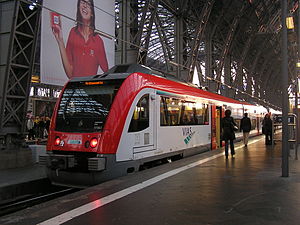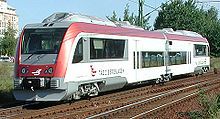Bombardier Itino
| Itino | |
|---|---|
|
Itino from VIAS in Frankfurt
|
|
| Number: | 57 delivered |
| Manufacturer: | Bombardier Transportation , Hennigsdorf plant |
| Year of construction (s): | from 2002 |
| Axis formula : | Bx '(2) By' (2 parts) Bx '(2) (2) By' (3 parts) |
| Length over coupling: | Sweden: 38.4 m or 54.75 m Odenwaldbahn: 39.47 m |
| Empty mass: | 61.5 t or 82.5 t |
| Service mass: | 77 t (Odenwaldbahn, 2/3 supplies) |
| Top speed: | Sweden: 140 km / h Odenwaldbahn: 140 km / h |
| Motor type: | up to 2006: 2 × MAN D 2842 LE 607, 500 kW, 12 cylinder EURO2 from 2008: 2 × FPT Vector8, 570 kW, 8 cylinder Stage3B (comparable to EURO5) |
| Power transmission: | until 2006: diesel-hydraulic, Voith Turbo T 212 bre from 2008: diesel-mechanical ZF Ecolife |
| Tank capacity: | 2 × 1,000 liters, usable 900 liters each |
| Brake: |
Retarder (2 ×): each briefly up to 450 kW, continuously 300 kW; ep brake |
| Control: | up to 4 vehicles in multiple traction |
| Coupling type: | Scharfenberg |
| Seats: | 107 2nd class + 12 1st class (Odenwaldbahn) |
The Bombardier Itino (spelling of the manufacturer: ITINO) is a two- or three-part diesel - hydraulic / diesel-mechanical multiple unit, depending on the version, with a top speed of 140 km / h to 160 km / h. It is offered with two separate diesel drives arranged in the end car and can be used up to four times coupled. Production takes place in the Hennigsdorf plant near Berlin.
Starting position
The Itino was developed by Adtranz and was intended to complement the Regio-Shuttle as a larger and more powerful vehicle . Before the first copy was even completed, Adtranz was taken over by Bombardier Transportation in 2001 . While the production of the Regio-Shuttle had to be handed over to Stadler Rail for antitrust reasons , the Itino remained with Bombardier. Due to this changed starting position, the Itino was now in competition with both the Regio-Shuttle and Bombardier's own talent family . Due to this particularly unfavorable situation in the already competitive market for local diesel multiple units, only 57 units (27 vehicles in Germany, 30 in Sweden) have been sold so far, while several competing models have been produced.
construction
The trains are extremely comfortable and, thanks to the good motorization, have very good acceleration properties. This means that the Itino can also be used on main routes between electrically operated trains. Each car body has a separate air conditioning system for the passenger and driver areas. These draw their electrical energy from two 90 kW generators that are driven by the two diesel engines.
The low-floor design enables comfortable and wheelchair-accessible entry. Only at each end of the train are stairs leading to an elevated area above the engines. The toilet is also disabled-friendly. The installation of lifts in the entrance area is possible, this was used for the Itino of the Erfurt Railway (EB) (ex-prototype), but was subsequently expanded.
The driver's cab (actually) does not have exterior mirrors to monitor the doors. This is done using two external cameras, the images of which are displayed on a monitor (visible in the image of the driver's cab on the left). At the special customer request, exterior folding mirrors were also retrofitted for Swedish vehicles. The vehicles ordered by RMV for the Odenwaldbahn (22 in 2005, four in 2010) were additionally equipped with interior video surveillance at the customer's request.
Like many other modern railcars, the Itino has a combined drive / brake lever. An additional driver's brake valve is available for emergency operation. The attachable operating lever is hidden in the desk. In addition, an emergency brake push button that works in parallel, electrically and pneumatically, provides the driver with safety.
The Itino has a modern electro-pneumatic brake system (manufacturer Knorr ) and a retarder (integrated in the turbo transmission T212 from manufacturer Voith or from 2008 in the manual transmission Ecolife from ZF ). Using a so-called blending brake concept, the brake computer uses the various brakes in combination depending on the braking power required, whereby the power of the wear-free brake is always used first. The pneumatic brake is only applied when there is an increased braking requirement.
In addition, the Itino is equipped with a roof cooling system for each drive system, which allows good heat dissipation even in hot ambient temperatures. Each roof cooling system consists of three fans that suck in the cooling air from the draft side through the cooling elements and then blow it out vertically upwards.
The Itino is characterized by the crash concept, which is new for rail vehicles. It has been further developed since the Erfurt prototype and corresponds to TSI 1 and TSI 2. The square blocks that look like buffers at the vehicle ends next to the Scharfenberg couplings are made of energy-consuming material. They work together with other measures, such as the crumple zone in motor vehicles. The system already proved its worth when it met a Swedish locomotive.
The car bodies are made of aluminum profiles. As with all modern railcars, the ends of the vehicles are made of fiberglass-reinforced plastic . The inclined struts in the ribbon windows reveal the same origin as the one-piece Regio-Shuttle RS1 developed by Adtranz in front of the Itino, but no longer have a static function here .
From 2006, EU funds were used to develop a technique to reduce pollutant emissions. For this purpose, a new engine was used, the hydraulic one was replaced by a mechanical gearbox and SCR catalytic converters were installed. The aqueous urea solution AdBlue is required for their operation , the reaction of which converts the nitrogen oxides into nitrogen and water vapor. An additional 150 liter tank is required for the urea. The weight of the drive unit could be reduced by 20%, while the power increased by 12% and the fuel consumption was reduced. The vehicles delivered from 2009 are equipped with this technology.
The German vehicles are run internally by Bombardier as IT D2.0.001 to IT D2.0.027. As usual, they were assigned their own numbers by the respective operators, so the Itino of the EB runs as VT201, the ITINOs of the Odenwaldbahn (operator VIAS GmbH ) as VT101 to VT126.
Technical details
- Transmission:
- until 2006:
- Voith Turbo T 212 bre (converter clutch clutch with integrated retarder and reversing gear , electronically controlled)
- Max. Transmission input power Sweden: 400 kW each at 2016 1 / min
- Max. Transmission input power Odenwaldbahn: each 430 kW at 2041 rpm
- Max. Transmission input power test vehicle EIB: 460 kW each at 2089 1 / min
- Transmission efficiency: over 90% in the area of the two fluid couplings at cruising speed
- since 2008:
- ZF Ecolife, 6-speed hydromechanical transmission (more powerful successor to the well-known Ecomat transmission)
- Max. Gear efficiency: 97.5%
- until 2006:
- Engine:
- until 2006:
- MAN D 2842 LE 607
- 12-cylinder V-engine
- Power: 500 kW / 680 PS
- Max. Torque : 2700 Nm
- Bore / stroke: 128/142 mm
- Displacement : 21.93 liters each
- Emission standard: UIC I / Euro 2
- since 2008:
- until 2006:
- Air conditioning:
- Manufacturer:
- Vehicle 1-13: Suetrak; from vehicle 14: BEHR cooling technology
- Refrigerant 134a
- Manufacturer:
commitment
Germany
So far, the Itino was operated by the DB as class 613 . It is listed as 0615 in the new vehicle settings register of the Federal Railway Authority. In Germany, apart from the Erfurt Railway (EB) (routes Erfurt– Kassel (until Dec. 2013) and Erfurt– Ilmenau ), only the Odenwaldbahn (routes Eberbach - Darmstadt / Frankfurt am Main , Groß-Umstadt Wiebelsbach –Frankfurt am Main ) owns this train , Darmstadt– Pfungstadt ). The EB vehicle is a prototype on which the more powerful engine planned for the Odenwaldbahn was tested.
As part of the modernization of the Odenwaldbahn, the vehicle management region Frankfurt RheinMain GmbH (fahma) ordered 22 two-part Itinos, which were delivered between August 5th and November 22nd, 2005. The multiple units have been in regular service since the timetable change on December 11, 2005. The increased motorization of the two-part Itino made it possible to implement the timetable construction for the “New Odenwaldbahn”, which was created without long compensation times, without the initially intended use of tilting technology .
Since the Odenwaldbahn still needs more units due to its great success, the RMV ordered four more vehicles in August 2007 and delivered them at the beginning of March 2010. This means that the reactivated route to Pfungstadt can also be served. Incidentally, these vehicles are the first to comply with the Stage3B emissions standard that came into force in 2012. They went into operation on May 3, 2010.
Sweden
There are another 30 Itino multiple units (twenty-four 2-car and six 3-car) in Sweden . The vehicles have the type designations "Y31" (2 parts) and "Y32" (3 parts). The road numbers are 1400–1405, 1412–1429 (Y31) and 1406–1411 (Y32). In contrast to the version used in Germany, they are equipped with extended winter equipment, such as heatable fuel storage tanks and snow plow blades. In addition, the furnishing of the passenger areas with tables, foldable armrests and power connections for laptops is more luxurious overall.
The trains are operated around Jönköping / Nässjö / Värnamo , between Borlänge - Malung , in Värmland and on the Gårdsjö – Håkantorp railway on behalf of the regional transport authorities JLT, TiB, Vämlandstrafik and Västtrafik . Another three vehicles were ordered in January 2008, seven in February 2008 and three in June 2008 and delivered between October 2009 and May 2010.
Accidents
Web links
- ITINO diesel multiple unit family on the manufacturer's side
- Gallery Odenwaldbahn the fahma
- järnväg.net (Swedish website with floor plans and photos of the Swedish railcars)
- Vehicle list of the fahma with the numbers of the 22 railcars of the Odenwaldbahn
Individual evidence
- ↑ zf.com ( Memento of the original from June 7, 2011 in the Internet Archive ) Info: The archive link was inserted automatically and has not yet been checked. Please check the original and archive link according to the instructions and then remove this notice.
- ↑ Harald Schönfeld: CLEAN with power. in: eisenbahn-magazin 10/2010, pp. 68–69
- ↑ Elmar Streun: RMV: Three new Itinos now ordered ( page can no longer be accessed , search in web archives ) Info: The link was automatically marked as defective. Please check the link according to the instructions and then remove this notice. , Darmstädter Echo , August 15, 2007








